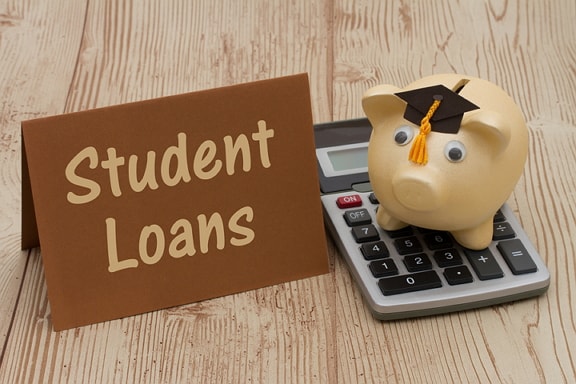Guide: How to Refinance Student Loans & The Best Ways to Refinance Student Loans
You received one or more student loans to pay for your college education. These loans were offered to you at an agreed-upon interest rate.
You are paying off these loans but would love if you could pay less interest each month. Student loan refinance may be perfect for you.
This is AdvisoryHQ’s guide that will show you how to refinance student loans in order to potentially save yourself a considerable amount of money.
We are going to show you the best way to refinance student loans as well as answer all your questions, such as:
- Can you refinance student loans?
- Can you refinance federal student loans or is there only private student loan refinance? And what is the difference?
- Will my credit score affect the student loan refinance process?
- What are all the things to know beforehand?
- What types of things will be on an application to refinance student loans?
Read on to find out more about how to refinance student loans this year.
See Also: Saving for College (Parents & Students) | Best Ways to Save for College
Student Loan Terms 101



Image Source: How to Refinance Student Loans
Throughout this article, we will be discussing how to refinance federal student loans and private student loans. Before we begin, it is important that you understand the main difference between the two loan types.
- Private Student Loans: These loans (or those picked up from private student loan refinance) are offered by private lenders. The government does not fund them at all. The bank sets all the terms.
- Federal Student Loans: These are student loans offered by the government. Can you refinance federal student loans? Yes. Should you refinance government student loans? Read more about that in the below section, “Know Lost Benefits of Federal Student Loan Refinance.”
Don’t Miss: Best Banks for Students | Ranking & Review
How to Refinance Student Loans
This lender essentially pays off that original student loan for you. Then you pay the lender back for that service though a brand-new set of monthly installments and a lower interest rate.
Lenders win because they are the ones now receiving your interest payments. You win because your monthly interest is lower. This is how student loan refinance saves you money each month.
Can you refinance student loans? The following are the four things you need to know first in order to possibly refinance student loans that are weighing you down in debt and save yourself real money. This is the best way to refinance student loans.
All-in-One Change Management Tools
Top Rated Toolkit for Change Managers.
Get Your Change Management Tool Today...
1. Know Your Student Loan Refinance Motives
Before you refinance student loans, you need to know why you want to refinance. This knowledge will better lead you to the best way to refinance student loans for your particular situation.
- Lower Interest Rate: Of course, the most common reason to refinance student loans is to lower your interest rate and pay less over the course of the next few years. Even a couple percentage points can save you considerably in cash.
- Shorten or Lengthen Term Length: Another reason you may want to refinance private student loans or federal ones is to adjust the length of time you will be paying. Perhaps you want a repayment plan with fewer years or more years.
- Change Companies: If you are unhappy with the company (or with the government program when you refinance federal student loans), you may simply want to switch lenders for a better overall experience.
- Switch to Fixed Rate: Variable interest rates can be scary. You never know if they are going to shoot up and cost you high interest payments. Switching to a fixed rate is another common reason people refinance student loans.
- Remove Your Cosigner: If you needed a parent or other person to cosign your original loan to start out, you might be looking to remove them now. Student loan refinance offers you that option.
2. Know Your Credit; Improve Your Credit
When you refinance student loans, credit is absolutely everything. After all, your new lender needs to know that, after paying off your original loan, he or she will be paid back.
In order to get an interest rate on your student loan refinance that will actually be lower than the rate you are paying now, you want to shoot for a credit score of at least 690 or more.
Though the credit score ranges can be slightly different from company to company, here is the following range guide for credit scores, in general terms:
- Very Bad: 300–599
- Poor: 600–649
- Fair: 650–699
- Good: 700–749
- Very Good: 750–799
- Excellent: 800–850
As this chart shows, you will most likely need at least a high “fair” if not “good” credit score in order to refinance student loans – and get a great new interest rate. You can learn your credit score for free through Credit Karma or Credit.com.



3. Resources for Improving Credit Scores
In order to refinance federal student loans or refinance private student loans, you may need to boost your credit score first. Here are two simple tips to get you started:
- Student Loans: What better way to improve your credit score to refinance student loans than to focus on… student loans. When you pay all of your student loan payments on time, you give your credit score a boost. Set up electronic or app payment reminders if you have to. Remember, paying on time is important for all payments when it comes to boosting credit.
- Drop Credit Card Balance: According to BankRate, it is a great idea to keep your balance no higher than 30% of what your credit limit is. Put a couple extra payments on your credit card over the next couple months.
4. Know Your Student Loan Refinance Options
If you are going to refinance student loans, you have to fully understand all the best student loan refinance options available to you. You want to know the strengths of each financial institution as well as the benefits they will offer you.
Take the time to research all the private lenders who offer student loan refinance. Double-check that they refinance federal student loans and refinance private student loans. Know what benefits they offer. See what term lengths are possible.
The more you know about these lenders, the better the decision you can make for yourself.
Related: How to Pay off Student Loans – What Is the Best Way? (Get Help Here!)
Resources for Student Loan Refinance Options
Here are a few online resources that will help you choose the best student loan refinance options for you and your current financial situation. These can start your research for choosing the right lender – one of the most important steps in getting student loan refinance.
- NerdWallet: The “10 Best Student Loan Refinancing Companies in 2016” list can help you learn more about lenders who refinance student loans. You can learn their interest rate ranges, eligible loan balances, and the average credit score needed.
- Student Loan Hero: This list provides information on six good lenders offering to refinance private student loans and refinance federal student loans. It also gives you information on interest rates and term limits.
- LendEDU: This list gives you LendEDU’s perspective on the best lenders who offer student loan refinance. It also offers information on how to refinance student loans with each lender specifically.
- Credible: This list is the most comprehensive, showing you the highest number of student loan refinance options. Credible offers you detailed information on each lender’s process.









Know Lost Benefits of Federal Student Loan Refinance
Private student loan refinance is cut and dried: you change one private loan for another. Now, we are going to speak about what happens when you refinance federal student loans specifically – a process that is a bit more complicated.
We have already answered the question, “Can you refinance federal student loans?” Yes, you absolutely can, but that does not mean you always want to. Remember, when you refinance federal student loans, it is only done by private lenders – essentially turning your federal student loan into a private loan.
If you refinance government student loans, you could end up with lower interest payments. However, you could also lose any of the benefits set up by the government. These could include:
- Loan forgiveness programs
- Loan cancellation programs
- Deferment (NerdWallet describes deferment as “the option to postpone subsidized student loan payments interest-free.”)
Before you refinance federal student loans, take the time to make sure those loans are not giving you wonderful benefits first. You want to make sure when you refinance government student loans that you are actually winning and not losing.
Student Loan Refinance Application Process
Once you have gone through the above four steps, and you feel confident in moving forward, the next step is the application process. To refinance student loans, you must apply to the lender.



Image Source: Private & Federal Student Loans Refinancing
This allows your new lender to learn about your credit score, how much money you make at your job, your financial history, etc. You will also give them information on whether or not you plan to do federal student loan refinance or private student loan refinance and how much those loans are currently worth.
These are the things that allow them to give you an interest rate offer so they can refinance federal student loans for you, refinance private student loans for you or refinance both!
Popular Article: Discover Bank Reviews – What Is Discover? (Student Loans, Saving & Checking Review)
Free Wealth & Finance Software - Get Yours Now ►
Can’t Get Approved? You Have Another Option
If you cannot get approved after your student loan refinance application process, search through student loan refinance options that offer cosigners. When somebody cosigns your loan, the lender will hold him or her responsible if you fail to pay.
A cosigner gives the lender extra confidence that he or she will receive the payments after you a refinance student loan to the company. These cosigners do not only have to be a parent; they can also be your spouse or family friends.
Can You Refinance Student Loans? Your Next Steps
Whether you will refinance federal student loans or refinance private student loans (or both!), you now understand the four things you need to know for the best way to refinance student loans.
Now get to work on determining what your goals are, improve your credit if needed, research plenty of student loan refinance options, and decide whether or not to pursue federal student loan refinance.
All you have to do now is to apply. Once approved, you will be able to save each month on your student loan payment, thanks to your new student loan refinance!
Read More: Sallie Mae Reviews (Loan Forgiveness, Student Loans, & Account Reviews)
AdvisoryHQ (AHQ) Disclaimer:
Reasonable efforts have been made by AdvisoryHQ to present accurate information, however all info is presented without warranty. Review AdvisoryHQ’s Terms for details. Also review each firm’s site for the most updated data, rates and info.
Note: Firms and products, including the one(s) reviewed above, may be AdvisoryHQ's affiliates. Click to view AdvisoryHQ's advertiser disclosures.



